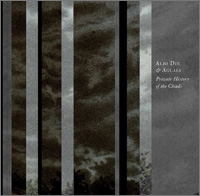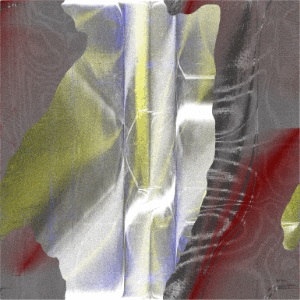
(03.01.09) Infraction Records curates this new entry to the already considerable body of collaborations involving Alio Die. There have already been communings with the likes of Robert Rich, Mathias Grassow, and Vidna Obmana. Here, though, Stefano Musso’s fellow-travellers are lesser known but closer to home. Aglaia is an Italian duo with a trio of albums on his Hic Sunt Leones label; Gino Fioravanti and Gianluigi Toso come trailing credentials in therapy, writing, painting, and teaching, to say nothing of alchemy and ortho-bionomy. In contrast with Musso, who has fully two decades of musical endeavors behind him, they’re comparative novices. But you wouldn’t have thought it. Theirs is a music whose apparent stasis enfolds within it endless subtle micro-variations. They bring with them from previous HSL releases an appealing aquatic/amniotic sound dimension, characterized by a combination of electronic sounds (analogies as the sleeve notes would have it) and processed acoustica moving as if in virtual circular breathing. Slow waves of soundflow suggestive of psycho-acoustic energy (if you’re a believer, otherwise just go with the flow) come with peripheral fragments of sonorities, carried on the wind, drifting as if at the edges of sleep, recalling the way echo plays in open landscapes.
That’s part of the method of this animist collective’s historical unfolding of its subjects’ textures and trajectories, yielding a series of luminous aerated tracts. Animists see a spiritual force residing in every element of the physical world. Nature is believed to be alive, imputing an inner life to leaves, lakes and the like. Dwelling on Private History of the Clouds brings this to mind before even entering its audio world, particularly in light of Alio Die’s predilection for “passion, nature and awakening” and Aglaia’s for worlds of feeling (“mondi sensibili,” as a previous album was called). But, lest this kind of talk scare off those averse to nature-hugging, note that the musical Grace inspiring this project is more a familiar of Pandit Prath Nan and Brian Eno than of Wyndham Hill and Hearts of Space.
From opener “Cumulus Congestus” (heaps of cloud masses) to “Cirrus” (wispy curls) the history unfolds couched in way-up-high, pure aetherial tonefloat, with odd bold blares of Fioravanti’s analogies, swathed in showers and sundry susurrations of the lower earth and skies released from capture within his accomplices’ arcane devices. There’s a sense of holism across the album’s six movements, though variations are clearly discernible. “Stratus” (blanket-like layers), for example, bears the characteristic medievo-gothic stamp of works in Musso’s recent Castles sonorisation series – the familiar drones and loops and field recordings providing a subtly evolving canvas for trails of elegiac psaltery. While “Radiatus” (broad parallel bands converging towards the horizon) takes more from the airy/aqueous elementalism of Aglaia’s Three Organic Experiences and Sacred Waters. “Nimbus” (generating precipitation) is serenity itself, albeit drenched. And “Perlucidus” (a layer with small spaces through which clear sky is visible) extends itself into 13+ minutes of freefloat, hanging oneirically in a light mist of treatments. At its more initimate, listening to the chronostatic electro-acoustic-glides in blue of Private History of the Clouds feels a little like watching dust particles in a room illuminated by light rays – variously filtered by alterations in shutter angles – now suspended almost immobile, now gently agitated by soft breeze.
Finally, in describing Alio Die’s work, it’s hard to avoid reaching for the meditative or devotional, invoking the sacral or incantatory. That’s only part of the resonance here, though, and Private History is notably less solemn than the Alio Die signature style, perhaps borne elsewhere by Aglaia’s energies. These will be labeled drone works, but there’s a weightless delicate quality about them that’s a far cry from the leaden pall of much generic ambient of the darker persuasion that typically taps into the Drone-zone. And usual suspect signifiers like spacey and pastoral would be better cast as stately and aerial (cf. An Aerial View, a similarly-inclined recent work by Oophoi). Ultimately this is genuinely Ambient music in the purist sense, in that the ear may pass blithely over the diverse cloud formations’ apparently static exteriors, or dive in to uncover micro-motions and subtle substrata in further archaeologies.
Private History of the Clouds is due for late-March release on Infraction.























![Luke’s Anger :: Ceiling Walker EP (Love Love) — [concise]](https://igloomag.com/wp/wp-content/uploads/2025/04/lukes-anger-ceiling-walker-vinyl_feat-75x75.jpg)

